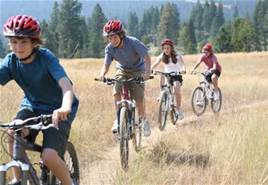May is National Bike Month!
Whether you are biking to school or work, there are so many ways to celebrate the power of the pedal! Here are a few things to keep in mind:
The Basics
Riding bikes is a great way for you to get active. Riding a bike can help you:
- Get in shape
- Lose weight
- Improve your overall health
- Lower your risk of health conditions like heart disease
- Save money on gas
- Protect the environment
- Explore your community
- Riding bikes is also a great way to spend time with your family and get active together.
Follow these safety tips every time you ride.
- Ride a bike that’s the right size for you.
- Check the brakes before you ride.
- Always wear a bike helmet.
- Wear bright colors and reflective tape.
- Ride in the same direction as cars.
- A bike crash could send you to the emergency room. The good news is that many bike injuries can be prevented. If you have kids, teach them these safety tips right from the start.
Take Action!
Make safe biking a habit and have a plan!
National Bike Month
Ride a bike that’s the right size for you.
Riders of any age should be able to put one leg on each side of the top bar (tube) of their bike with both feet flat on the ground. Otherwise, the bike isn’t safe to ride.
Check the brakes.
Make sure the brakes are working before you ride.
If you are choosing a bike for a child, choose one that brakes when the rider pedals backwards. Young children’s hands aren’t big enough or strong enough to use hand brakes.
Always wear a bike helmet!
Get in the “helmet habit”—wear a helmet every time and everywhere you ride a bike. A bike helmet is the best way to prevent injury or death from a bike crash.
Make sure your helmet is certified. Look for a sticker on the inside that says “CPSC.” This means it’s been tested for safety.
Bike helmets only protect you if you wear them the right way. Every time you put your helmet on, make sure that:
- The helmet is flat on the top of your head
- The helmet is covering the top of your forehead
- The strap is buckled snugly under your chin
Kids grow quickly—check regularly to make sure their helmets still fit.
Replace your helmet if you crash.
Even if your helmet doesn’t look cracked or damaged, it might not protect you in another crash.
Make sure people can see you easily.
Drivers can have a hard time seeing bike riders, even during the day. Follow these tips to help drivers see you:
- Wear neon, fluorescent, or other bright colors.
- Put something on your clothes or bike that reflects light, like reflective tape.
Try to plan ahead so your bike rides are over before it gets dark. If you are going to ride at night:
- Make sure your bike has reflectors on the front, back, and wheels.
- Put battery powered lights on your bike. A red light is for the back, and a white light is for the front – just like with cars.
Follow the “rules of the road.”
- Look both ways before entering the street.
- Ride in the same direction as the cars.
- Stop at all stop signs and intersections.
- Use hand signals to show others what you plan to do next.
- For a left turn, look behind you, hold your left arm straight out to the side, and turn carefully.
- For a right turn, hold your left arm out and up in an “L” shape.
- To signal that you are stopping, hold your left arm out and down in an upside-down “L” shape.
![]()
![]()
![]()
Use your left hand to make these signals for left turn, right turn, and stop.
Stay alert.
Paying attention to the things around you can help you stay safe.
- Look for potholes, rocks, wet leaves, or anything that could make you fall.
- Be aware of cars that are parking or backing up.
- Listen for traffic and other activity around you. Don’t wear headphones when you ride.
- If you are riding in bad weather, go slowly.

